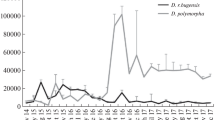Abstract
A methodology for hybrid computational modeling for special crisis cases is developed. Extreme phenomena and transient processes occurring suddenly in various biophysical systems are explored. The methods of mathematical biophysics require flexible expansion due to situationally activated intense influencing factors, which has been demonstrated well by the COVID-19 pandemic with the effects of virus superspreading and the instant launch of new COVID waves. Several economically important and hard-to-predict extreme biophysical processes with very rapidly changing evolutionary stages are compared. A classic example of a phenomenon disrupting the functioning of a biophysical system is a rapid invasion outbreak. Stages of the invasion process pass beyond the framework of the evolutionarily established regulatory principles in a short time interval and, therefore, can have a devastating effect. The feedback principle in biocybernetics leads to a scenario in which the rapid outbreak stage is followed by the effect of a deep crisis, both for an aggressive invader and its biophysical environment. A local population can die. Other sudden crises are provoked by an incorrectly regulated algorithm for influencing populations that are valuable for the economy. In this study, a previously discussed method for organizing hybrid computational structures on the basis of differential equations is developed. The events of switching the forms of equations are found by calculating auxiliary biophysical indicators that specify the moments of redefinitions for changing the stages of the investigated process. An advanced version of a hybrid structure and model scenarios for the collapse effect are presented. Logical errors in estimating the nonlinear dynamics with expert regulation of the impact on a biophysical system are demonstrated. Using an alternative set of predicates, a simulation analysis of launching an invasive outbreak of the population for a dangerous alien invader violating biophysical equilibrium is carried out. The scenario singles out the invasion stages at which measures for controlling an alien species are efficient before an active invader destroyed the environmental resources like Lymantria dispar invasion in Canada.









Similar content being viewed by others
REFERENCES
A. Y. Perevaryukha, Tech. Phys. 67, 651 (2022). https://doi.org/10.1134/S1063784222090043
A. Y. Perevaryukha, Tech. Phys. 67, 523 (2022). https://doi.org/10.1134/S1063784222070088
A. Y. Perevaryukha, Tech. Phys. Lett. 48, 268 (2022). https://doi.org/10.1134/S1063785022090048
I. V. Trofimova, A. Yu. Perevaryukha, and A. B. Manvelova, Tech. Phys. Lett. 48, 305 (2022). https://doi.org/10.1134/S1063785022110025
A. V. Leonov, O. V. Chicherina, and L. V. Semenyak, Water Resour. 38, 774 (2011). https://doi.org/10.1134/S0097807811040075
D. I. Kryuchkov and A. G. Zalazinskii, Vestn. Komp’yut. Inform. Tekhnol., No. 9, 22 (2013).
A. Y. Perevaryukha, Tech. Phys. Lett. 49 (2023). https://doi.org/10.1134/S1063785023010054
E. N. Brooks and J. E. Powers, ICES J. Marine Sci. 64, 413 (2007).
C. Jørgensen and E. Holt, J. Sea Res. 75, 8 (2013).
M. V. Forental’, Vestn. Komp’yut. Inform. Tekhnol., No. 12 (66), 29 (2009).
V. V. Mikhailov, A. Yu. Perevaryukha, and Yu. S. Reshetnikov, Inform.-Upr. Sist., No. 4 (95), 31 (2018). https://doi.org/10.31799/1684-8853-2018-4-31-38
A. F. Evans and K. Collis, Trans. Am. Fisher. Soc. 143, 899 (2014).
D. Costa and A. Almeida, Zoologia 35 (2018).
W. Ricker, J. Fisher. Res. Board. 11, 559 (1954).
P. V. Veshchev, G. I. Guteneva, and R. S. Mukhanova, Russ. J. Ecol. 43, 142 (2012). https://doi.org/10.1134/S1067413612020154
J. Roughgarden and F. Smith, Proc. Natl. Acad. Sci. U. S. A. 93, 5078 (1996).
D. Singer, SIAM J. Appl. Math. 35, 260 (1978).
M. J. Feigenbaum, Commun. Math. Phys. 77, 65 (1980).
J. Guckenheimer, Commun. Math. Phys. 70, 133 (1979).
A. A. G. Hall et al., Agricult. Forest Entomol. 17, 292 (2015).
G. H. Walter and R. Hengeveld, Autecology: Organisms, Interactions and Environmental Dynamics (CRC, Boca Raton, FL, 2014).
M. P. Hill, in Biological Invasions in South Africa, Vol. 14 of Invading Nature - Springer Series in Invasion Ecology (Springer, Cham, 2020). https://doi.org/10.1007/978-3-030-32394-3_19
A. Yu. Perevaryukha, J. Comput. Syst. Sci. Int. 50, 491 (2011). https://doi.org/10.1134/S1064230711010151
A. Yu. Perevaryukha, Cybern. Syst. Anal. 52, 623 (2016). https://doi.org/10.1007/s10559-016-9864-8
A. Y. Perevaryukha, Tech. Phys. Lett. 49 (2023). https://doi.org/10.1134/S1063785023010042
T. N. Solov’eva, Inf.-Upr. Sist., No. 4 (83), 60 (2016). https://doi.org/10.15217/issn1684-8853.2016.4.60
A. Yu. Perevaryukha, Biophysics 61, 334 (2016). https://doi.org/10.1134/S0006350916020147
R. Abbasov, R. Karimov, and N. Jafarova, in Ecosystem Services in Azerbaijan (Springer, Cham, 2022). https://doi.org/10.1007/978-3-031-08770-7_1
A. Sukhinov, Yu. Belova, A. Nikitina, and V. Sidorya-kina, Mathematics 10, 2092 (2022). https://doi.org/10.3390/math10122092
V. V. Mikhailov and A. V. Spesivtsev, in Intelligent Distributed Computing XIII, Proceedings of the International Symposium IDC 2019, Vol. 868 of Studies in Computational Intelligence (Springer, Cham, 2020). https://doi.org/10.1007/978-3-030-32258-8_53
Funding
This study was supported by the Russian Science Foundation, project no. 23-21-00339, “Development of Methods for Scenario Modeling of Extreme Invasive Processes in Ecosystems Taking into Account Counteracting Factors on the Basis of Dynamically Redefinable Computational Structures,” project leader A.Yu. Perevaryukha.
Author information
Authors and Affiliations
Corresponding author
Ethics declarations
The author declares that she has no conflicts of interest.
Additional information
Translated by E. Bondareva
Publisher’s Note.
Pleiades Publishing remains neutral with regard to jurisdictional claims in published maps and institutional affiliations.
Rights and permissions
About this article
Cite this article
Perevaryukha, A.Y. Modeling Threshold Effects of Rapid Collapse and Devastating Invasion Outbreaks in Biophysical Systems. Tech. Phys. Lett. 49, 43–54 (2023). https://doi.org/10.1134/S106378502303001X
Received:
Revised:
Accepted:
Published:
Issue Date:
DOI: https://doi.org/10.1134/S106378502303001X




